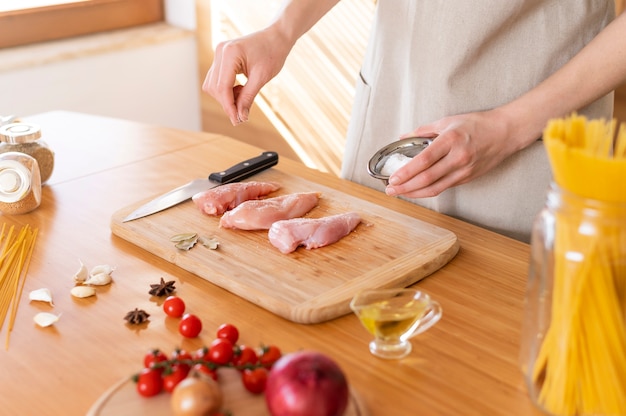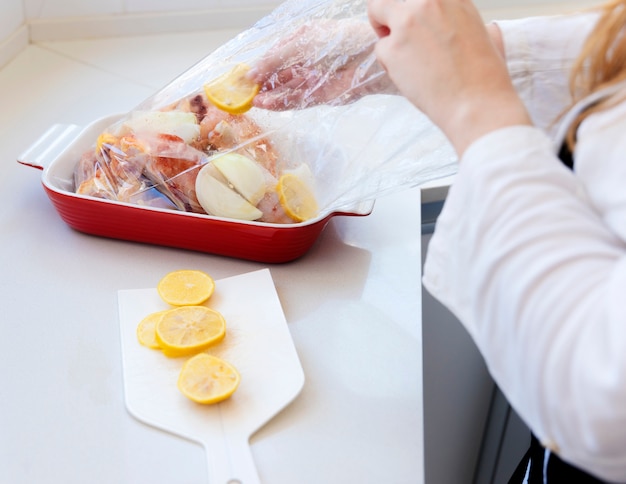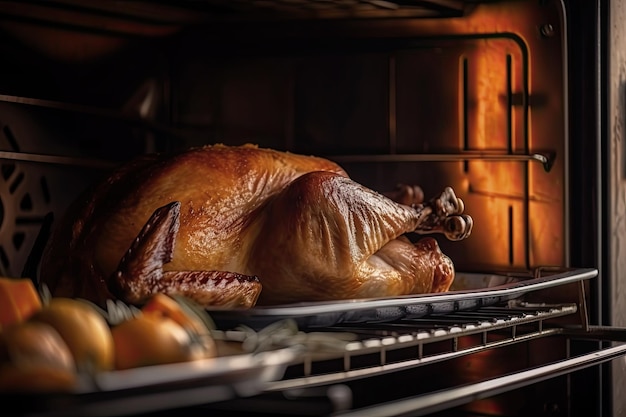You know that feeling, right? You're picturing a delicious, juicy pork chop, perfectly cooked. But then, you open the oven, and... disaster! It's either dry and tough, or still pink in the middle. That's the classic pork chop cooking dilemma, and I’ve been there too, many times! But don't worry, after years of trial and error in the kitchen, I've figured out the secrets to achieving consistently perfect oven-baked pork chops. Get ready to banish those dry, disappointing pork chop nightmares for good!
Part 1: Understanding the Fundamentals of Pork Chop Perfection

Before we dive into the specific cooking times, let's break down the essential principles that will ensure your pork chops turn out succulent and delicious every time.
1.1: The internal temperature: The Key to Safety and Tenderness
The most important factor to remember is the internal temperature. You want to make sure your pork chop reaches a safe internal temperature of 145°F (63°C). This is the point where any harmful bacteria are eliminated, leaving you with a perfectly cooked and delicious pork chop.
It's important to note that the temperature should be taken in the thickest part of the meat, avoiding the bone if it’s bone-in. This will ensure you've cooked the entire chop through without overcooking the thinner parts.
1.2: The Thickness Factor: Not all Pork Chops Are the Same
Have you ever noticed how some pork chops seem to cook faster than others? That's because thickness plays a crucial role in determining the cooking time. Think of it like this: thicker chops need more time to cook through, so you need to adjust your cooking time accordingly.
A thin pork chop, say around ?? inch thick, might only need about 10-15 minutes in the oven, while a thicker chop, around 1 inch thick, could take 20-25 minutes or even longer. So, always check the thickness of your pork chops before you start cooking.
1.3: Bone-In vs. Boneless: A Culinary Consideration
Now, let's talk about the bone. bone-in pork chops take a bit longer to cook compared to boneless pork chops. Why? Because the bone acts like a heat sink, absorbing some of the heat and slowing down the cooking process.
This can actually be a good thing! Because the bone slows down the cooking, it allows the meat to cook more evenly and prevents it from drying out. So, if you're aiming for extra juicy and flavorful pork chops, bone-in is the way to go.
Part 2: Oven-Baked Pork Chop Cooking Times: A Comprehensive Guide

Now that we've covered the fundamentals, let's dive into the specific cooking times for different types and thicknesses of pork chops. Remember, these are just guidelines, and the actual cooking time may vary slightly depending on your oven and the individual chop.
2.1: Boneless Pork Chop Cooking Times
Here’s a helpful guide for boneless pork chops:
| Thickness (inches) | Cooking Time (Minutes) |
|---|---|
| 1/2 inch | 10-15 minutes |
| 3/4 inch | 15-20 minutes |
| 1 inch | 20-25 minutes |
Remember, these are just estimates. It's always a good idea to use a meat thermometer to ensure your pork chop has reached the safe internal temperature of 145°F (63°C). Don’t rely solely on the timer!
2.2: Bone-In Pork Chop Cooking Times
For bone-in pork chops, you'll need to add a few extra minutes to the cooking time because of the bone, as we discussed earlier.
| Thickness (inches) | Cooking Time (Minutes) |
|---|---|
| 1/2 inch | 15-20 minutes |
| 3/4 inch | 20-25 minutes |
| 1 inch | 25-30 minutes |
Again, these are just estimates. Use a meat thermometer to ensure the internal temperature reaches 145°F (63°C).
Part 3: Pre-heating the Oven: A Crucial First Step

You might think pre-heating is just a formality, but trust me, it's essential for achieving perfectly cooked pork chops. Here’s why:
3.1: Why Pre-heating is So Important
Imagine this: you place a cold pork chop into a cold oven. The meat will take a long time to cook, and chances are it won't cook evenly. Pre-heating your oven creates a consistent heat environment, allowing the pork chops to cook evenly and efficiently.
It’s like giving your pork chops a head start! A preheated oven ensures that the heat penetrates the meat quickly and evenly, resulting in a more uniformly cooked and juicy pork chop.
3.2: The Ideal Oven Temperature
For oven-baked pork chops, I recommend pre-heating your oven to 375°F (190°C). This temperature is perfect for creating a crispy exterior while keeping the interior moist and juicy.
Part 4: Choosing the Right Oven Rack: A Culinary Tip
Don't underestimate the power of rack placement! Choosing the right rack can make a big difference in how your pork chops cook.
4.1: Why Rack Placement Matters
The ideal goal is to ensure even heat distribution around your pork chop. If you place the rack too low, the heat might not reach the top of the chop, resulting in uneven cooking. And if you place it too high, the top of the chop might over-brown before the inside is cooked through.
4.2: The Middle Rack: The Sweet Spot for Even Cooking
In most cases, the middle rack is the best option for oven-baked pork chops. It offers the most consistent heat circulation, allowing for even cooking from all sides.
Part 5: Searing for Extra Flavor: Unlocking a World of Deliciousness
Okay, now here’s a trick that will take your pork chops from good to phenomenal: searing. Searing adds a beautiful caramelized crust, locking in moisture and boosting the flavor.
5.1: The Benefits of Searing
Searing involves cooking the pork chops over high heat for a short time, creating that beautiful, golden-brown crust. This process not only intensifies the flavor, but it also helps to seal in the juices, resulting in a more tender and flavorful pork chop.
5.2: Searing Techniques: Two Popular Methods
You can sear your pork chops in a cast-iron skillet or on a grill pan. Whichever method you choose, make sure the pan is nice and hot before you add the pork chops. Cook for about 2-3 minutes per side, or until a beautiful golden-brown crust forms.
You can sear your pork chops before or after you season them. I personally prefer to sear them first, as it helps to create a barrier that will prevent the seasonings from burning.
Part 6: Seasoning and Marinades: Elevate Your Pork Chops
Now that we've discussed the basics of cooking, let’s focus on the flavor. Seasoning and marinades play a crucial role in transforming your pork chops into a culinary masterpiece.
6.1: Basic Seasonings: Simple Yet Effective
A simple combination of salt, pepper, and garlic powder is a classic choice for pork chops. It's a timeless trio that always delivers a delicious flavor profile.
But don’t be afraid to experiment! You can add a pinch of paprika for a touch of smoky flavor, or a sprinkle of rosemary or thyme for a more earthy taste. Let your creativity shine!
6.2: Marinades: Unlocking a World of Flavor
Marinades are like magic potions! They tenderize the meat and infuse it with incredible flavor. Here are a few of my go-to marinades for pork chops:
- Soy Sauce Marinade: A classic and flavorful choice! Combine soy sauce, minced garlic, grated ginger, and a touch of honey. It’s a savory and sweet blend that’s incredibly delicious.
- Lemon Herb Marinade: Fresh and vibrant! Mix lemon juice, olive oil, chopped fresh herbs like rosemary and thyme, and a clove of garlic. It’s bright and tangy, making it a perfect match for pork.
- Honey Mustard Marinade: Sweet and tangy! Combine honey, Dijon mustard, and a splash of apple cider vinegar. It’s a perfect balance of sweetness and tang that will leave your taste buds happy.
Marinate your pork chops for at least 30 minutes, or even better, overnight, for the most flavorful results. The longer you marinate, the more intense the flavor will be.
Part 7: Resting: The Secret to Juicy, Flavorful Pork Chops
After you've cooked your pork chops to perfection, the temptation is to immediately dig in! But resist that urge for a few minutes. Resting your pork chops is a critical step to ensure that they are as juicy and flavorful as possible.
7.1: Why Resting is So Important
Think about it this way: when you cook meat, the juices get pushed towards the center. If you cut into it right away, all those delicious juices will spill out, leaving you with dry, disappointing pork chops.
Resting allows those juices to redistribute evenly throughout the meat, making your pork chops extra juicy and tender. It's like giving your pork chops a chance to relax and settle before serving.
7.2: How Long to Rest
I recommend resting your pork chops for about 5-10 minutes before slicing and serving. This will give them enough time to reabsorb those precious juices. You’ll be so glad you waited!
Part 8: Serving Suggestions: Taking Your Pork Chops to the Next Level
Now, your perfectly cooked pork chops deserve a delicious and equally amazing accompaniment. Here are some serving suggestions that will make your pork chops shine even brighter:
8.1: Sides for a Complete and Satisfying Meal
To create a balanced and satisfying meal, consider serving your pork chops with:
- mashed potatoes: A classic comfort food pairing that’s always a crowd-pleaser. Try adding a little garlic, chives, or herbs for extra flavor.
- Roasted Vegetables: A healthy and delicious side that complements the savory flavor of pork chops. Roast your favorite vegetables like broccoli, carrots, asparagus, or Brussels sprouts.
- Pasta Salad: A refreshing and light option that adds a touch of brightness to your meal. Make a simple pasta salad with your favorite vegetables, herbs, and dressing.
These are just a few ideas to get you started! Feel free to get creative and experiment with different side dishes to find your perfect pairing.
8.2: Sauces for an Extra Touch of Flavor
A drizzle of sauce can take your pork chops to the next level. Here are a few sauce suggestions to elevate your dish:
- Apple Sauce: A sweet and tangy sauce that’s a perfect complement to the savory flavor of pork.
- Mushroom Sauce: Rich and earthy, adding a depth of flavor to your pork chops.
- Peppercorn Sauce: A spicy and flavorful sauce for those who enjoy a bit of heat.
Experiment with different sauces and combinations to find your perfect pairing.
Part 9: FAQs: Answering Your Most Pressing Questions
Here are some common questions about cooking oven-baked pork chops:
9.1: Can I cook pork chops in the Oven at a Lower Temperature?
Yes, you can cook pork chops at a lower temperature, like 350°F (175°C). Just keep in mind that you'll need to adjust the cooking time accordingly. It might take a little longer to reach the safe internal temperature of 145°F (63°C).
For example, if you’re cooking a 1-inch thick boneless pork chop at 350°F, it could take about 25-30 minutes. Remember, it’s always better to err on the side of caution and cook for a few extra minutes than to undercook the pork chops.
9.2: How Do I Know When My Pork Chops are Done?
The best way to determine if your pork chops are cooked through is to use a meat thermometer. Insert the thermometer into the thickest part of the meat, avoiding the bone if it’s bone-in. Your pork chops are done when the internal temperature reaches 145°F (63°C).
Don’t rely solely on the appearance of the pork chop. Sometimes, they might appear cooked on the outside but still be undercooked in the middle. The meat thermometer will give you a definitive answer.
9.3: What Happens if I Overcook My Pork Chops?
overcooked pork chops will be dry and tough. They will also lose their juicy flavour and become less appealing to eat. To prevent overcooking, use a meat thermometer and don’t cook them beyond the recommended time.
If you find that your pork chops are a bit overcooked, try adding a little sauce or gravy to help moisten them. You can also try slicing the pork chops thinly to make them more tender.
9.4: Can I Cook Pork Chops in a Foil Packet?
Yes, you can cook pork chops in a foil packet. This method helps to retain moisture and flavour, resulting in a more tender and flavorful pork chop.
Simply place the seasoned pork chops in a foil packet, add some vegetables or aromatics like garlic, onions, or herbs, and bake in a preheated oven at 375°F (190°C) for about 20-25 minutes, or until the internal temperature reaches 145°F (63°C).
This method is also great for meal prep, as you can cook the pork chops and vegetables together in one packet.
9.5: Can I Freeze Pork Chops?
Yes, you can freeze pork chops. Wrap them tightly in plastic wrap or aluminum foil and place them in a freezer-safe bag. They can be frozen for up to 3-4 months. To thaw frozen pork chops, transfer them to the refrigerator overnight.
Do not thaw them at room temperature as this can promote bacterial growth. Frozen pork chops will cook a little slower, so you may need to increase the cooking time by a few minutes.
Everyone is watching

How to Cook Frozen Lobster Tails Perfectly: A Step-by-Step Guide
RecipesLobster. Just the word conjures up images of lavish meals, special occasions, and a taste of luxury. But let's...

Pigs in a Blanket Cooking Time: How Long to Bake for Perfect Results
RecipesAh, pigs in a blanket. Just the name conjures up images of those delightful little parcels of crispy pastry en...

Pork Fillet Cooking Time: How Long to Cook It Perfectly
RecipesPork fillet, or tenderloin as it's sometimes called, is a real favourite in our house. It's so versatile, and...

The Ultimate Guide to Tender, Juicy Pulled Pork
RecipesRight, let's talk pulled pork. It's one of those dishes that just screams "comfort food," doesn't it? I mean...

The Ultimate Guide to Cooking Sweet Potatoes: From Roasting to Mashing
RecipesSweet potatoes. Just the name conjures up images of warm, comforting dishes, bursts of vibrant color, and a to...
